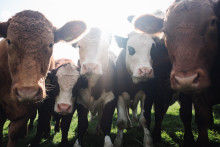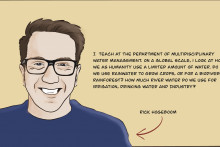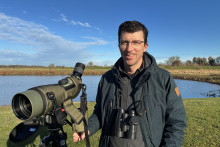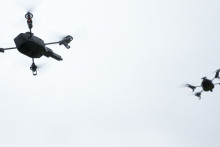It takes 3000 litres of water to produce a 200-gram beef steak. While getting a soy burger of the same size onto your plate will only cost the world 200 litres. Scientists everywhere warn that, in order to sustain our planet, we need to dramatically change our diet, to replace meat and dairy with plant-based food. The large water footprint of animal products is one part of the issue. We asked the world’s leading expert on water footprint, UT Professor Arjen Hoekstra, exactly how much water we could save if we took the most radical step in changing one's diet: turning vegan. The answer? If you are an average Dutch consumer, by becoming a vegan you could save about 1300 litres a day.
'The average Dutch consumer has a food-related water footprint of about 2800 litres a day. If the Dutch consumer would become vegan, he or she would have an average food-related water footprint of approximately 1500 litres a day. That is a reduction of 46%,' says Professor Hoekstra, after he and his postdoc Joep Schyns took the time to do some calculations. Calculations that have never been done before in the Dutch context.
what is a water footprint?
- The water footprint is a concept developed by Professor Arjen Hoekstra. It measures the amount of water used to produce a product or a service, anything from a hamburger to a pair of jeans. It looks at both direct and indirect water use and includes water consumption and pollution over the full production and supply chain.
- The water footprint has three components: green, blue and grey.
- The green water footprint refers to rainwater that is directly used where it falls; it is the water that evaporates and that can thus not be used for another purpose.
- The blue water footprint is water from groundwater or surface water (rivers, lakes etc.) that is abstracted and not returned, thus not available for use for another purpose either.
- The grey water footprint is the amount of fresh water required to assimilate pollutants to meet specific water quality standards.
- While the water footprint differs in every country and region, the global water footprint of humanity in the period 1996-2005 was 9087 billion cubic meters per year (74% green, 11% blue, 15% grey). Agricultural production contributes 92% to this total footprint.
- The water footprint per product is different depending on local production conditions. The biggest differences are not caused by climate, but by agricultural practices and technology used in the area.
- The production of one kilogram of beef requires approximately 15 thousand litres of water (93% green, 4% blue, 3% grey water footprint). The water footprint of a 150-gram beef burger is 2350 litres in the world on average, while a soy burger costs about 160 litres.
Source of data: waterfootprint.org
The numbers are clear. Meat and other animal products have a much larger water footprint, and therefore a much bigger impact on the environment, than its plant-based counterparts. What does this stem from? 'Essentially, either we can use land and water to produce plants that we eat ourselves or we can grow feed for animals and eat the animal products,' explains Professor Hoekstra, from the UT Water Management group. 'The latter is very inefficient. About 3000 litres of water is used to produce a 200-gram steak. This number includes all water used to sustain the cow during its lifetime and to bring its meat to customers: the cow’s feed needs to be grown and watered, the animal drinks, and there is water used during the meat processing. The water footprint includes water used in every step of the supply chain. In this case, 99% of a steak's water footprint is in the first stage, though. In the feed production.'
Inefficient and harmful for the planet
In simple words, raising animals for food is inefficient and, given the large scale at which we keep livestock, it is also harmful for the planet, says Hoekstra. 'Inefficiency doesn't count only for the use of water. To raise animals for meat requires land; 77% of all agricultural land in the world is used for livestock. In many areas, this leads to deforestation and loss of biodiversity. Animals, cows in particular, also have a high carbon footprint. Cows produce a lot of methane. There is also a moral element to eating meat. How ethical is it to raise animals in order to kill them, particularly because there is no need to for a healthy diet? It appears that for every animal product there is an alternative plant-based product with the same nutritional value but much smaller claim on our limited land and water resources.'
'Eating no meat is the number one step to take'
All in all, the environment could be helped by consumers choosing to eat less meat. 'The biggest step you can make to lower your water footprint is becoming a vegetarian,' says Hoekstra. 'Becoming vegan will naturally have an even bigger impact, but the step is smaller. By eating vegetarian you reduce your water footprint by 38%, by eating vegan it is about 46%. That is why I would say that eating no meat is the number one step to take. If you never shower again, you will save about 50 litres a day. If you replace all meat by proper plant-based alternatives, the average Dutch consumer will save about 1060 litres a day.'
Water conflicts on the horizon
Arjen Hoekstra predicts that, if we don't change our current patterns, more and more water problems are awaiting us. 'If we don't reduce our water footprint, we can expect a series of disastrous events. They are already creeping in. Just look at the situation in Cape Town, a major city that basically ran out of water last year. The amount of water conflicts will increase. If there is no water supply, there won't be a harvest. People will starve. It will be the poor in dry regions that are hit first, because the rich can buy water from ‘the outside’. In the Netherlands we are vulnerable as well though, because 95% of our water footprint relates to imported commodities and lies outside the country, partly in water-scarce regions. But if we use all land that is now used for producing animal feed, we can produce a much bigger part of our own food than we currently do.’

Professor Arjen Hoekstra. Photo by Rikkert Harink.
Although regular consumers, meaning anyone of us, can do their part and change their consumption, there are certainly other ways of reducing the global water footprint than just giving up animal products. 'There are other solutions,' says Hoekstra. 'For one, governments should set water footprint caps per river basin, establishing how much water can be used per river basin every part of the year. This will prevent rivers running dry and groundwater levels drop, the things we see happening now in many places around the world. Furthermore, we could develop a water footprint benchmark for each product based on what is reasonable given good practices available. We could urge companies to become transparent and to set water footprint reduction targets for their products. Finally, we could work towards international agreements on fair and sustainable trade. At some point, politicians need to agree on reducing our water footprint globally. To solve the problem, we need to involve governments, industry, investors - and consumers.'
Indeed, the consumer perspective is only one part of the puzzle, but a part nonetheless, points out professor Hoekstra. ‘Our water footprint is distributed all over the world. If you reduce it, it's hard to determine where exactly it will make an impact, but you need to remember that everything counts.’
Diary of a five-day vegan
I’m a meat eater. And a dairy eater. A fish eater, a vegetarian, a vegan. I love food. I do not plan to give any of it up, but I also think that reducing our consumption of animal products is one of the most important things we can do to protect this planet. So I go vegan for a week, to experience it, to see how easy or difficult it would be to live this lifestyle. This is how it went.
Day 1:
I’ve prepared for this week. It has been planned to every detail: bought supplies of soy milk and soy yoghurt, gathered all the vegan recipes I could find at home and planned all my lunches. I’m all set to be vegan!
Breakfast is easy. My cereals are already vegan, so all I need to do is to replace my regular yoghurt with soy yoghurt. For lunch I meet with a small group of UT researchers and employees that have joint me on this week’s mission. We’ve ordered the meal upfront from the campus caterer. We enjoy our sandwiches with hummus and salads, discovering that I’m the only regular meat eater at the table. That doesn’t matter. I’ve prepared for this challenge. Tonight I’m making Italian caponata: eggplant, celery, onion, tomato sauce and some homemade garlic bread. One of the favourites in our house.

Day 2:
Another successful day. Our ‘vegan’ group has a decent lunch in the Faculty Club, where they serve us soup and a salad with fried mushrooms. For dinner I make some nice ‘chilli sin carne’: beans, peppers, spicy sauce, rice. I don’t understand why people keep asking me if I feel okay. I’m totally fine.

Day 3:
I no longer feel totally fine. I have stuck to my vegan diet. I even refused coffee in a restaurant, because they didn’t have any non-dairy milk that I could use. I ate my vegan breakfast, salad for lunch and made tostadas with avocado for dinner. In quantities, I’ve eaten and slept enough. But I feel tired and irritated. My body seems to be going through some sort of a withdrawal, craving meat and chocolate with an alarming intensity. But I will prevail!

Day 4:
I have prevailed, but I feel just as tired and irritated. To cheer myself up, I decide to go out for dinner and to the movies. After a rather extensive research I find an Indian restaurant in the area with a couple of vegan options. The cinema kiosk is also a pleasant surprise: all their snacks have clear labels, marking any animal products contained. I feel relieved. Going to see a movie without snacks just wouldn’t be right. Now I just need to spend ten minutes reading all the labels and we are good to go.

Day 5:
Day five would be best described by words that are not really suitable for print. My stomach hurts, I feel tired despite sleeping a lot more than the usual eight hours. I’m extremely irritable. I keep evaluating. Is this worth it? How bad could it be to have a cheeseburger? Do I care more about a burger or the planet? I try to persevere, but in the evening I give up. I eat fish. Immediately I feel better. Miracle! It might have all been in my head, but that doesn’t matter now. I feel better.
I expect to also feel ashamed. I have failed on my noble quest. I ate meat. The issue is, I feel fine. I must be a horrible person because I don’t feel any guilt over eating the fish (and a steak two days later).
In conclusion: Eating more vegan? By all means. Only vegan? Absolutely not. It might be more sustainable for the planet, but it does not seem to sustain my body. Luckily, being a vegetarian a few days a week also helps – and I can manage that. At least, I have managed that for the last couple of years.
The final numbers
I’ve embarked on the vegan journey not only to see how it would feel. I mainly wanted to know how much it would help the environment. The initial numbers were encouraging. An average Dutch consumer would reduce their weekly water footprint by 46%, saving thousands of litres of water. I kept a detailed diary of everything I ate during ‘a regular meat eating week’ and during my ‘vegan week’ (or to be precise, of what I would have eaten if I didn’t give up on day five. I did plan all my meals, after all). But the result was rather disappointing.
Apparently, I’m not an average Dutch consumer. By turning vegan, I only reduced my water footprint by 20%. According to Arjen Hoekstra’s calculations, in the meat week I had an average food-related water footprint of 3092 litre/day. In the vegan week I had an average food-related water footprint of 2481 litre/day. I really hoped for more, but I try to remember: every litre counts.










